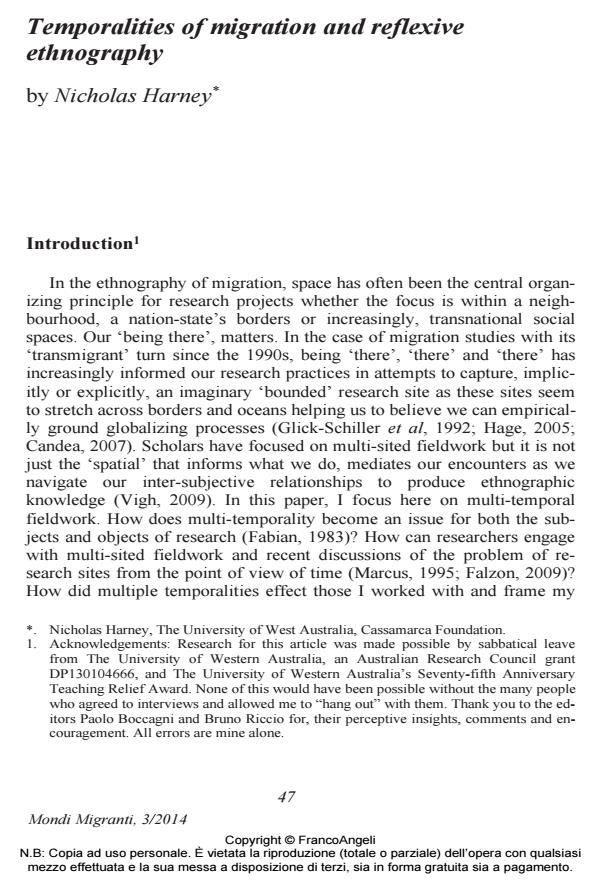Temporalities of migration and reflexive ethnography
Titolo Rivista MONDI MIGRANTI
Autori/Curatori Nicholas Harney
Anno di pubblicazione 2015 Fascicolo 2014/3
Lingua Italiano Numero pagine 16 P. 47-62 Dimensione file 57 KB
DOI 10.3280/MM2014-003003
Il DOI è il codice a barre della proprietà intellettuale: per saperne di più
clicca qui
Qui sotto puoi vedere in anteprima la prima pagina di questo articolo.
Se questo articolo ti interessa, lo puoi acquistare (e scaricare in formato pdf) seguendo le facili indicazioni per acquistare il download credit. Acquista Download Credits per scaricare questo Articolo in formato PDF

FrancoAngeli è membro della Publishers International Linking Association, Inc (PILA)associazione indipendente e non profit per facilitare (attraverso i servizi tecnologici implementati da CrossRef.org) l’accesso degli studiosi ai contenuti digitali nelle pubblicazioni professionali e scientifiche
Negli ultimi decenni gli etnografi hanno faticato a trovare la metodologia di ricerca appropriata per studiare il nostro mondo altamente globalizzato. C’è stato, infatti, un intenso e proficuo lavoro che ha aperto nuovi ambiti ricerca. In questo articolo, vorrei esaminare una seconda dimensione che - credo - gli etnografi della migrazione dovrebbero prendere in considerazione: il tempo. Gli etnografi devono affrontare la coesistenza di più beni temporali. Nell’articolo classifico tre diversi beni temporali in gioco nel processo di migrazione: indeterminazione, cronologia e convergenza. Mi concentro sull'Italia, come terreno di diversi progetti migratori e frangenti temporali e rifletto sulle implicazioni di questi diversi fattori e su ciò che significa metodologicamente per gli studi antropologici. La ricerca sulla migrazione necessariamente invita ad altri luoghi e ad altri tempi, sia per quanto riguarda la messa in opera delle pratiche etnografiche sia per la produzione delle conoscenze. Secondo Fabian la sfida degli etnografi è quella di analizzare entrambi i dilemmi introspettivi: studiare la mobilità attraverso lo spazio-nazione e vedere come tale ricerca venga influenzata da altri luoghi, da altri tempi.
Parole chiave:Temporalità , ricerca sul campo, etnografia, migrazione, Italia.
- ‘You just get used to waiting’: Exploring the temporal dimensions of in-country educational experiences Kate Naidu, in Time & Society /2023 pp.169
DOI: 10.1177/0961463X231157883 - Permanent Precarities: The Experience of Temporality of Tunisian Migrants in Sicily’s Transformed Agricultural Strip Andrea Calabretta, in Journal of International Migration and Integration /2025
DOI: 10.1007/s12134-025-01326-1
Nicholas Harney, Temporalities of migration and reflexive ethnography in "MONDI MIGRANTI" 3/2014, pp 47-62, DOI: 10.3280/MM2014-003003